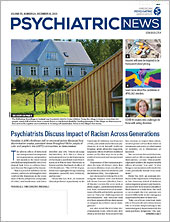Over the past decade, many psychiatrists have realized the value of collecting objective health information from their patients in between scheduled visits. Devices such as smartphones, smartwatches, or other wearable sensors can capture everything from users’ biometric data to their responses to brief surveys on mood.
Even as “wearables” become more popular, some researchers are looking ahead to the next tech frontier: the “invisibles.” These are the tools that can passively monitor vital signs with minimal or no input from the users.
Geriatric psychiatrist Ipsit Vahia, M.D., the director of the Technology and Aging Laboratory at Boston’s McLean Hospital, sees passive monitoring as critical to the patient population he serves.
“Current monitoring tools typically require some engagement from a person, even if it entails only putting a phone right next to the bed each night,” he said. For people with dementia, Parkinson’s disease, or other cognitive disorders, ensuring this regular engagement is problematic. “We need to find ways to collect important data from those patients who cannot provide the data to us.”
Vahia noted that vitals that can be readily collected with a passive sensor like heart rate, respiration, or movement are useful in psychiatry since they are biomarkers of anxiety and stress.
Vahia has been testing the feasibility of a device known as Emerald to aid in the monitoring of patients with dementia. Emerald is a small box that continually emits radio signals into the surrounding space much like a wireless router. Whenever the waves hit an object (like a person), they become distorted. By analyzing how wave patterns in a room change over time, Emerald can identify such movements as a person walking or chest movements while a person sleeps.
The device includes machine-learning software that can identify expected wave patterns over a typical day. Abnormal changes in movement due to excess pacing or disturbed sleep—which could signal that an individual is experiencing a medical problem—can be quickly identified. This information can then be transmitted remotely to relevant personnel, including nursing home staff or the patient’s physician.
Vahia has teamed up with Emerald designer Dina Katabi, Ph.D., the Andrew & Erna Viterbi Professor of Electrical Engineering and Computer Science at the Massachusetts Institute of Technology, to assess the movement patterns of nursing home patients with dementia. The group’s pilot studies have shown that a person’s average walking speed and daily spatial patterns can serve as biomarkers for neuropsychiatric symptoms such as apathy, insomnia, or cognitive difficulties.
Vahia said that a device like Emerald could be attractive to many patients and health care professionals since it can collect vital health data without the need for a camera. The Emerald device is also more practical than video monitoring, as waves from the device can pass through solid objects, which allows it to monitor larger spaces (like a multiroom house).
David Maman, the co-founder and CEO of Israeli tech company Binah.ai, said he believes cameras also have an important role in passive monitoring.
“An average person might spend up to 50% of his or her waking time looking at a camera, even when not actively using it,” Maman said, referring to the time people spend on their phones, tablets, or computers.
With just a 60-second scan of a person’s face, the Binah.ai software can assess subtle changes in light reflection on the skin and acquire data including heart rate, respiratory function, and mental stress (derived from heart rate variability, or the differences in time from beat to beat)—even while working in the background.
The program can be seamlessly integrated into other platforms, so physicians can have the Binah.ai software running on their computer while conducting a telemedicine session and view real-time changes in their patients’ vitals.
Binah.ai is seeking FDA approval to market their software as a medical device in the United States.
“The field of virtual health care has exploded in the past few months” due to COVID-19, Vahia said. “Any tools that can provide patient data without requiring staff contact are becoming invaluable.”
Vahia noted the importance of monitoring stress and anxiety in patients with COVID-19, as these symptoms can impair the immune system and worsen the infection “To optimally manage a COVID-19 infection, we need to monitor patient physiology and behavior at the same time,” he said.
The applications of the invisibles will likely continue well beyond COVID-19. “Like many other psychiatrists, I have switched to full-time telemedicine during this pandemic,” Vahia said. “And like many colleagues, I think telemental health care will remain a standard of care after the pandemic ends.
“To make telehealth care even better, we need to supplement it with what we may call digital collateral information,” he said. That includes specialty devices such as Emerald but also phone- or tablet-embedded programs, as phones are available almost everywhere and to almost everyone.
“With the help of these collateral tools, psychiatrists can practice personalized, data-based care with their patients in a way that was previously not conceivable.” ■

